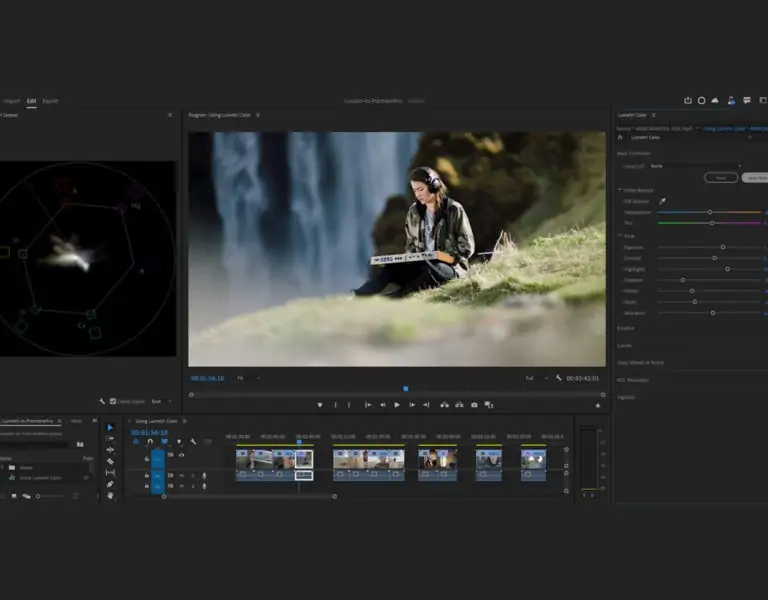
Ahead of the 2024 Sundance Film Festival, Adobe announced new audio features in Premiere Pro (beta) to improve the editing experience.
Available now in beta, Premiere Pro’s new innovations include interactive fade handles on clips in the timeline so editors can simply click and drag to create a variety of custom audio fades. Additionally, new AI-powered audio category tagging automatically identifies and labels clips with icons for dialogue, music, sound effects or ambient noise, giving editors one-click access to the most relevant tools for each type of audio. Redesigned clip badges make it easier to see which clips have effects, quickly add new effects, or adjust effect settings. More modern and intelligent waveforms dynamically resize when track height is changed, while improved clip colours make it easier to see and work with audio on the timeline.
In addition to the new audio features available now in Premiere Pro (beta), Adobe’s groundbreaking AI-powered Enhance Speech tool – which instantly removes unwanted noise and improves poorly recorded dialogue – will become generally available to all Premiere Pro customers in February.
Together, these new features and innovations represent a major audio workflow update for Premiere Pro, empowering editors to create videos with high-quality audio and get to their final mix with fewer clicks.
“Sound creates meaning and adds impact to film and video – it has the power to help tell a story, and move us in ways visuals alone cannot,” said Ashley Still, senior vice president and general manager, Adobe Creative Cloud. “We’re proud to empower filmmakers with new workflows that make editing audio more intuitive, so whether they’re new to audio or experienced pros, Premiere Pro makes it faster and easier to find the perfect tool.”
Premiere Pro’s new audio workflows give customers everything they need to precisely control and improve the quality of their sound, saving editors significant time so they can focus on what they do best: storytelling. The latest features include:
- Interactive fade handles – Editors can create custom audio transitions faster than ever by simply dragging clip handles to create audio fades.
- New Essential Sound badge with audio category tagging – AI automatically tags audio clips as dialogue, music, sound effects or ambience, and adds a new icon so editors get one-click, instant access to the right controls for the job.
- Effect badges – New visual indicators make it easy to see which clips have effects, quickly add new ones, and automatically open effect parameters right from the sequence.
- Redesigned waveforms in the timeline – Waveforms intelligently resize as the track height changes on clips, while gorgeous new colours make sequences easier to read.
For the sixth year in a row, Adobe’s creative tools are the most popular with Sundance Film Festival filmmakers: This year’s annual Sundance Institute survey found that Premiere Pro is the festival’s most popular video editing software, used by more than half (57%) of Sundance films, including Dìdi (弟弟), Will & Harper, FRIDA, Thelma, and Little Death. Over two-thirds (68%) of this year’s entrants used either Premiere Pro or Frame.io to bring their stories to life, and 83% of the 2024 films used one or more Adobe Creative Cloud applications, including After Effects, Photoshop and the Substance 3D Collection.
“I cut the movie on Premiere Pro – it’s my go-to editing software because the interface is so intuitive and smooth,” said Josh Margolin, writer, director and editor of Thelma. “We also leaned on Frame.io heavily for reviewing cuts, colour passes and VFX. It was super helpful because of how precise you can be in giving feedback. Throughout post, a handful of our core team members weren’t in the same country, so Frame.io made some of the remote elements of the process a lot smoother and more conversational – allowing us to give notes and resolve them in real time.”
“On Dìdi, we edited in Premiere Pro Productions, which allowed both Chris [Tennant, assistant editor] and I to be in the project at the same time and effortlessly pass sequences back and forth,” said Arielle Zakowski, editor of Dìdi (弟弟). “We also had a handful of scenes that take place within the world of a 2008 computer (we’re talking AIM, MySpace, etc.). For those sequences, we used Photoshop and Illustrator to create the computer assets, and then we built our fake computer and created the animation in After Effects. It was super easy to send material back and forth between the programs during this process and allowed us to work quickly and efficiently as well as have many different people help out with different aspects of the process.”
“Because our show Penelope was shot in the beautiful but remote forests of Washington, we had to think creatively in terms of our post workflow,” said Alex Regalado, Duplass Brothers Productions, head of post for Penelope. “Premiere Pro, Camera to Cloud and Frame.io and gave us the power to keep everyone connected – including our assistant editors in Los Angeles, our VFX Supervisor in New York, and our local production team in Seattle.”
















